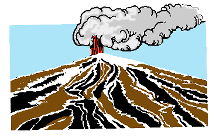 1) Outgassing
1) Outgassing
Gas dissolved in rock (magma) within the Earth is released
to the atmosphere when the magma rises as lava flows
on the surface. The gas escapes the rock due to the decrease in
pressure above the Earth surface.
2) Accretion of Planetesimals rich in Volatiles
Recall the inhomogeneous model for Earth's formation?
In the final stages of formation, planetesimals made
primarily of the lighter elements (called volatiles because
they readily vaporize at low temperatures) deposited
much if not most of our water, carbon dioxide, etc.
Evolution of the Earth's Atmosphere
As the earth surface cooled and volcanism slowed down, more and more
of the atmosphere was condensed into the warm oceans. Water,
Carbon Dioxide and Nitrogen were the most abundant gases (NO
Oxygen gas!), Later nearly all the water and CO2 will reside
in the oceans, leaving a mostly Nitrogen rich atmosphere (like we have today).
The Greenhouse Effect and the Carbon Cycle
Atmospheric CO2 traps thermal radiation (heat)
coming from the Earth's surface, keeping it from escaping
to cold, empty space. Our Earth
has an important buffer cycle, the Carbon Cycle, which
keeps the greenhouse effect and thus the temperature of
Earth in check:
If Earth gets too cool..
Cool oceans absorb less CO2. It precipitates out as
carbonate sediments to the ocean floor. The carbon is released back
into the atmosphere during volcanism. Increased atmospheric
CO2 increases and strengthens the greenhouse effect,
bringing the temperature back up to normal.
If Earth gets too warm...
Warm oceans more readily absorb atmospheric CO2.
If you remove CO2 from the atmosphere, the Earth will
cool due to its reduced `greenhouse' effect, bringing the temperature
back down. In this way, the oceans and volcanism kept the Earth at
a very similar temperature. This allowed for liquid water
over the last 4 billion years.